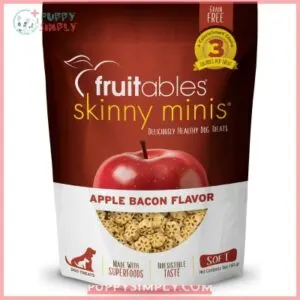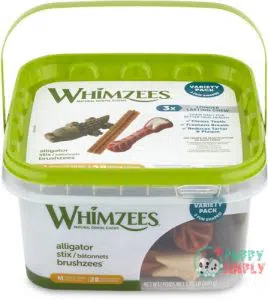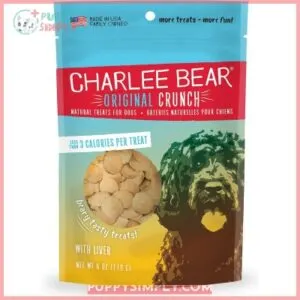This site is supported by our readers. We may earn a commission, at no cost to you, if you purchase through links.
 Imagine this: You’re in the park, your furry friend’s eyes locked onto yours, eagerly awaiting a command.
Imagine this: You’re in the park, your furry friend’s eyes locked onto yours, eagerly awaiting a command.
You’re armed with the best low-calorie dog training treats, ready to reward each successful sit, stay, or heel without packing on the pounds.
As a savvy pet parent, you know that treats are the secret sauce to training success, but they shouldn’t tip the scales.
Dive into our top 10 picks for 2024, where flavor meets fitness in every bite-sized reward.
Table Of Contents
- Key Takeaways
- Importance of Low-Calorie Treats
- Choosing the Right Treats
- 10 Best Low-Calorie Dog Training Treats
- 1. Beef Liver Dog Training Treats
- 2. Wellness Soft Puppy Bites Lamb Salmon
- 3. Cloud Star Chewy Liver Dog Treats
- 4. Full Moon Chicken Jerky Dog Treats
- 5. Blue Wilderness Salmon Dog Treats
- 6. Pet Botanics Bacon Dog Treats
- 7. Zuke’s Mini Naturals Chicken Treats
- 8. Fruitables Skinny Minis Dog Treats
- 9. Whimzees Dental Dog Treats
- 10. Charlee Bear Liver Dog Treats
- Health Considerations
- Beyond Treats: Overall Diet
- Frequently Asked Questions (FAQs)
- Can low-calorie dog treats still be appealing to dogs with a lower sense of smell or older dogs?
- How do the textures of low-calorie dog treats affect a dog’s dental health, especially for those with existing dental issues?
- Are there any low-calorie dog treats specifically designed for dogs with food sensitivities or allergies?
- How can I ensure the freshness and longevity of low-calorie dog treats once the package is opened?
- Are there any environmental considerations taken into account in the production of low-calorie dog treats?
- Conclusion
Key Takeaways
-
Nutritional Balance and Health: Low-calorie dog treats are essential for maintaining a healthy weight and preventing obesity-related health issues. They should be used as part of a balanced diet, focusing on nutritional balance and portion control. High-quality, nutritious ingredients are crucial for the overall well-being and longevity of dogs.
-
Training and Behavior Modification: Low-calorie treats are highly effective for training purposes, allowing for frequent rewards without the risk of overfeeding. They can be categorized based on their value (high, medium, low) to maximize motivation and maintain learned behaviors. Treats with strong, natural flavors and scents are particularly appealing to dogs, including those with a lower sense of smell or older dogs.
-
Health Considerations and Dietary Needs: It’s important to consider the dog’s overall diet and health conditions, including food sensitivities or allergies. Treats designed for these specific needs have limited ingredients, novel proteins, and no common allergens. Veterinarians may also recommend customized diets for balanced nutrition.
-
Storage and Sustainability: Proper storage of treats in airtight containers in a cool, dry place is essential to maintain their quality and safety. Additionally, some manufacturers are focusing on producing more sustainable pet foods with lower environmental footprints, reflecting a growing trend towards eco-friendly pet care.
Importance of Low-Calorie Treats
When it comes to your dog’s health and training, choosing the right treats is more important than you might think. Veterinarians often emphasize the importance of low-calorie treats in maintaining a healthy weight for your dog.
By incorporating treats that are both nutritious and low in calories, you’re not only rewarding your dog but also contributing to their overall well-being and longevity.
Why Healthy Treats Matter
You’re about to learn why it’s crucial to incorporate healthy, low-calorie treats into your dog’s diet. With over half of dogs in the U.S. being overweight or obese, the treats you choose play a significant role in managing your pet’s weight and overall health.
Nutritional balance, treat variety, and ingredient quality are key.
Caloric awareness and appropriate treat size ensure flavor without excess calories, supporting a healthy, protein-rich diet.
The 90/10 Rule Explained
Most dog owners aren’t aware that treats should only make up a small fraction of their pet’s daily caloric intake, adhering to the 90/10 rule where treats account for just 10% of the total calories.
- Reward Distribution: Use treats as a positive reinforcement, not a meal substitute.
- Caloric Budgeting: Keep track of the calorie count for portion control.
- Nutritional Balance: Choose low-calorie dog training treats to maintain a healthy diet.
- Reinforcement Strategy: Opt for treat substitution with nutritious options for a balanced reinforcement strategy.
Choosing the Right Treats
When selecting the best low-calorie dog training treats for your furry friend, it’s essential to consider their individual preferences and the value of the treats in their eyes. High-value treats are typically moist and aromatic, perfect for capturing your dog’s attention during training.
Medium and low-value treats can be used for maintaining behaviors and regular rewards.
Your vet can offer guidance on the most nutritious and appropriate treats for your dog’s health and training needs.
High-Value Vs. Medium-Value Vs. Low-Value Treats
When choosing the right treats for your dog’s training, it’s essential to understand the difference between high-value, medium-value, and low-value treats. As veterinarians, we recommend using high-value treats for introducing new behaviors and distracting environments to provide maximum motivation.
Medium-value treats work well for maintaining learned behaviors and good reinforcement throughout the day.
Use low-value treats for continued good behavior and fading out food rewards.
Assessing your dog’s preferences and always considering nutritional balance supports healthy weight and effective behavioral reinforcement through properly calibrated treat values tailored to your pet.
Identifying Your Dog’s Preferences
To find the perfect treat for your dog, it’s essential to observe their reactions to different textures, flavors, and treat sizes. Note their enthusiasm for chewy versus crunchy options, and which flavors—like beef or chicken—spark the most joy.
Effective training hinges on these preferences, ensuring treats are a powerful reinforcement.
For sensitive pups, opt for low-fat, gentle options that won’t upset their stomachs.
10 Best Low-Calorie Dog Training Treats
When selecting the best low-calorie dog training treats, it’s essential to consider your dog’s health and dietary needs. These top 10 picks for 2024 offer a variety of flavors and textures, ensuring there’s a healthy option for every pup.
With treats like Beef Liver Dog Training Treats and Wellness Soft Puppy Bites Lamb Salmon, you can reward your dog without compromising their diet or well-being.
1. Beef Liver Dog Training Treats
You’ll find the Beef Liver Dog Training Treats to be a perfect choice for your pup’s training sessions, as they’re not only low in calories but also made from high-quality beef liver and heart, ensuring a nutritious reward.
These treats are ideal for maintaining your dog’s health while keeping them motivated during training. They’re grain-free and contain no added chemicals or fillers, making them a safe option for dogs with sensitive stomachs or allergies.
Plus, with less than one calorie per treat, you can train your dog without worrying about weight gain.
- Only 1 calorie per treat, supporting weight control
- Made with high-quality beef liver and heart, rich in nutrients
- Grain-free and free from added chemicals, suitable for dogs with dietary restrictions
- Limited to beef flavor, which may not suit all taste preferences
- May be more expensive than other treats due to high-quality ingredients
- Not suitable for dogs with beef allergies
2. Wellness Soft Puppy Bites Lamb Salmon
Wellness Soft Puppy Bites Lamb & Salmon are all-natural, grain-free treats specifically formulated for puppies, providing a nutritious and delicious reward that’s perfect for training. Made in the USA, these treats cater to your puppy’s developmental needs with a natural source of DHA and Omega 3 for healthy brain and vision growth.
The bite-sized morsels are free from corn, wheat, soy, and artificial additives, ensuring a safe and wholesome treat for your young companion.
- Contains DHA and Omega 3 for developmental health
- Free from corn, wheat, soy, and artificial colors/flavors
- Made in the USA with premium, all-natural ingredients
- Some puppies may experience digestive upset
- A third of the product may be crumbled, reducing treat quality
- Reports of negative reactions in some puppies
3. Cloud Star Chewy Liver Dog Treats
Cloud Star Chewy Liver Dog Treats are a hit with dogs due to their soft texture and delicious flavor, making them an excellent choice for training sessions. These treats are baked in the USA and are free from artificial flavors or colors, wheat, and corn, ensuring a healthy snack for your furry friend.
Their chewy texture won’t dry out, crumble, or leave a greasy residue, making them perfect for long training sessions. Plus, with real chicken liver as the main ingredient, they’re packed with taste that dogs love.
- Soft and chewy texture ideal for training
- Free of artificial flavors, colors, wheat, and corn
- Made with real chicken liver for a taste dogs love
- Formula change has led to concerns about smell and health effects
- New formula contains pork liver and peas, which may not suit all dogs
- Reports of the new formula being linked to DCM in dogs
4. Full Moon Chicken Jerky Dog Treats
For a high-quality, low-calorie option, consider Full Moon Chicken Jerky Dog Treats, which are crafted with care in the USA using real whole muscle chicken breast. These treats aren’t only delicious but also packed with wholesome, nutritious ingredients, including organic cane sugar, vinegar, and rosemary, making them an irresistible choice for your furry friend.
They’re perfect for adult dogs of all sizes and support a special diet that’s grain-free and high in protein.
- Made with real chicken breast for a high-quality protein source
- Free from fillers, artificial flavors, preservatives, or colors
- Supports a grain-free, high-protein diet
- Some reports of white mold on treats
- Occasional complaints about treats being hard
- Price increases noted since the Covid pandemic
5. Blue Wilderness Salmon Dog Treats
If you’re looking for a grain-free option that’s packed with protein and essential fatty acids, Blue Wilderness Salmon Dog Treats are an excellent choice for your adult dog of any breed size. These treats are formulated with salmon as the first ingredient, ensuring a high-quality protein source that supports muscle development and maintenance.
Added omega 3 and 6 fatty acids contribute to healthy skin and a shiny coat, while the inclusion of vitamins and antioxidants supports overall health. The grain-free recipe is ideal for dogs with sensitivities to corn, wheat, or soy, and it avoids common allergens like chicken and beef, making it a safe option for dogs prone to allergies.
- High-quality salmon as the first ingredient
- Added omega fatty acids for skin and coat health
- Grain-free and free from common allergens
- Reports of metal contamination in one associated treat
- Chicken listed as an ingredient despite claims
- Kibble may be too hard for some dogs to chew
6. Pet Botanics Bacon Dog Treats
You’ll find Pet Botanics Bacon Dog Treats to be an excellent choice for low-calorie training rewards, offering over 500 bite-sized, moist chews per bag. These treats are made with real pork liver and enhanced with BotaniFits, a unique blend of natural nutrients, ensuring your dog receives a healthy, flavorful snack.
Perfectly sized for repetitive reward training, they’re easy to carry and provide the focus and motivation your dog needs, potentially shortening the learning curve. Recommended by thousands of professional trainers, these treats are suitable for dogs of all sizes.
- Only 3 calories per treat, ideal for maintaining a healthy weight.
- Over 500 treats per bag, providing great value.
- Recommended by professional trainers for effective training.
- May contain white bugs in rare cases, requiring inspection before use.
7. Zuke’s Mini Naturals Chicken Treats
Zuke’s Mini Naturals Chicken Treats offer a low-calorie, tasty option for training your dog, with only 2 calories per treat and a formula that’s free of common allergens like corn, wheat, and soy. These treats are crafted in the USA using quality ingredients from around the world, ensuring your furry friend gets the best.
The chewy, easy-to-tear texture makes them perfect for dogs of all sizes, providing a rewarding experience that supports their training and reinforces good behavior.
- Low in calories, ideal for frequent rewards
- Free from common allergens, suitable for sensitive dogs
- Made in the USA with high-quality ingredients
- Recent recipe change has led to harder treats with an unpleasant smell
- Added potatoes and cane sugar may not be ideal for all dogs
- Some customers have found suitable replacements due to these changes
8. Fruitables Skinny Minis Dog Treats

For your dog’s training and reward sessions, consider Fruitables Skinny Minis Dog Treats, which are low in calories and packed with natural flavors. These treats are crafted with care in the USA, ensuring quality and safety for your pet.
The organic ingredients, free from common allergens like corn, wheat, and soy, provide a nutritious snack that supports your dog’s health. With flavors like Apple Bacon and Pumpkin Mango, they’re sure to entice even the pickiest of eaters while contributing to their dietary well-being.
- Organic and made in the USA, ensuring high-quality standards
- Gluten-free and devoid of corn, wheat, soy, or artificial additives
- Rich in antioxidants, vitamins, and fiber for a nutritious treat
- Some dogs may not find the flavors appealing
- The small size of the treats may not be ideal for larger breeds
- Not recommended for dogs with kidney disease due to specific dietary needs
9. Whimzees Dental Dog Treats

If you’re looking for a dental treat that’s both low in calories and beneficial for your dog’s oral health, Whimzees Dental Dog Treats are an excellent choice. These treats are designed with a unique knobby shape that promotes blood flow through the gums, helping to prevent bad breath and tartar buildup.
They’re also rich in vitamins, antioxidants, and fiber, supporting not just oral health but good digestive health as well. Made sustainably in the Netherlands without any artificial ingredients, these vegetarian, gluten-free treats are perfect for dogs of all sizes and life stages.
- Promotes oral health and freshens breath
- Rich in vitamins, antioxidants, and fiber
- Free from artificial ingredients, gluten, and meat
- May not be suitable for dogs with very strong chewing habits
- Some dogs mightn’t find them as appealing as meat-based treats
- The size and hardness may not be ideal for very small or very large breeds
10. Charlee Bear Liver Dog Treats

You’ll find Charlee Bear Liver Dog Treats to be a perfect training companion, as each crunchy treat contains just 3 calories and is made with real liver for a taste dogs love. These treats are crafted with care in the USA, ensuring they’re not only delicious but also made with wholesome ingredients.
Ideal for all dogs, they’re especially handy during training sessions, providing a low-fat reward without the mess. Easy to carry in your pocket, they won’t leave stains, smells, or crumbs, so you can focus on reinforcing good behavior.
- Only 3 calories per treat, supporting a healthy weight
- Made with real liver, offering a savory flavor that dogs enjoy
- Convenient for on-the-go training with no mess
- Some dogs may prefer a softer texture
- Limited flavor variety compared to other treats
- Not suitable for dogs with specific dietary restrictions against liver products
Health Considerations
Veterinarians possess a deep understanding of animal health, including the best nutritional practices for dogs. They recommend giving high-calorie treats sparingly to prevent weight gain and suggest healthy, homemade alternatives.
Trusting their science-based advice ensures your dog’s diet and training treats are both safe and beneficial.
When to Give High-Calorie Treats Sparingly
While exploring the best low-calorie dog training treats, it’s crucial to remember that high-calorie options should be used sparingly to avoid potential health issues. Caloric moderation is key in maintaining your dog’s nutritional balance and weight management.
Occasional indulgence can be rewarding, but monitor treat frequency, especially with chicken treats for older dogs or those with sensitive stomachs, to prevent weight gain from excess treat calories.
DIY Healthy Treat Alternatives
After considering when to give high-calorie treats sparingly, it’s time to explore your dog’s diet further with DIY healthy treat alternatives. Veterinarians recommend focusing on nutritional balance and portion control in homemade recipes.
- Peanut Butter Pops: Freeze small dollops of unsalted peanut butter.
- Meat Cubes: Bake lean meat cuts and cut into bite-size pieces.
- Veggie Bites: Steam and puree vegetables for grain-free treats.
- Fruit Slices: Offer fresh, size-appropriate fruit pieces.
Beyond Treats: Overall Diet
While treats play a crucial role in training, your dog’s overall diet is equally important for their health and well-being.
Veterinarians, with their deep understanding of animal nutrition and health, can offer science-based advice on choosing the right dog food that complements the low-calorie treats you use for training.
They’ll help ensure your dog’s diet is balanced, nutritious, and tailored to their specific needs.
The Role of Dog Food in Nutrition
In addition to considering the caloric content of treats, it’s crucial that you also focus on the overall quality of your dog’s daily diet to ensure they’re receiving balanced nutrition.
| Aspect | Importance |
|---|---|
| Dog food nutrition | Foundation of canine health |
| Balanced diets | Ensures all nutritional needs are met |
| Premium ingredients | Supports optimal health and energy levels |
| Natural alternatives | Offers a grain-free, dental-friendly option |
| Canine health | Enhanced with soft, fat, and fiber for wellness |
Considering Healthier Dog Food Options
As you focus on providing low-calorie treats to maintain your dog’s health, it’s also crucial to consider upgrading their overall diet to ensure they’re receiving optimal nutrition.
Premium ingredients and fresh formulations contribute to a balanced diet, preventing issues from an unbalanced diet or food allergies.
Customized diets and tailored plans from veterinarians can offer balanced nutrition, complementing your choice of healthier dog food options and low-calorie dog training treats.
Frequently Asked Questions (FAQs)
Can low-calorie dog treats still be appealing to dogs with a lower sense of smell or older dogs?
Yes, low-calorie dog treats can still be appealing to dogs with a lower sense of smell or older dogs.
Treats made with strong, natural flavors and scents, like those from freeze-dried meats or fish, can stimulate even a less sensitive olfactory system.
Additionally, softer textures cater to older dogs with dental issues, making the treats not only palatable but also easy to consume.
How do the textures of low-calorie dog treats affect a dog’s dental health, especially for those with existing dental issues?
Crunchy low-calorie treats can help clean teeth by mechanical action. However, if your dog has dental issues, softer treats may be safer to avoid further damage.
Are there any low-calorie dog treats specifically designed for dogs with food sensitivities or allergies?
Yes, there are low-calorie dog treats designed for dogs with food sensitivities or allergies.
Look for treats with limited ingredients, novel proteins, and no common allergens like chicken or beef.
How can I ensure the freshness and longevity of low-calorie dog treats once the package is opened?
To maintain freshness, store low-calorie dog treats in a cool, dry place. Ideally, use airtight containers to prevent moisture and staleness.
Keep them away from direct sunlight and heat to preserve their quality.
Are there any environmental considerations taken into account in the production of low-calorie dog treats?
Your quest for eco-friendly dog treats is noble, as the pet food industry does leave a significant environmental pawprint.
Wet diets, in particular, have been linked to a higher environmental impact compared to dry or homemade diets.
Manufacturers are increasingly aware of this issue, and some are striving to produce more sustainable pet foods by using ingredients with lower environmental footprints.
Conclusion
Dispelling the myth that tasty treats can’t be healthy, the best low calorie dog training treats of 2024 offer the perfect blend of flavor and nutrition.
Consult your vet for tailored advice, ensuring your pup stays fit while mastering new tricks.
With these top picks, you’re all set to train effectively without compromising your furry friend’s waistline.
Keep it fun, keep it healthy, and happy training!










